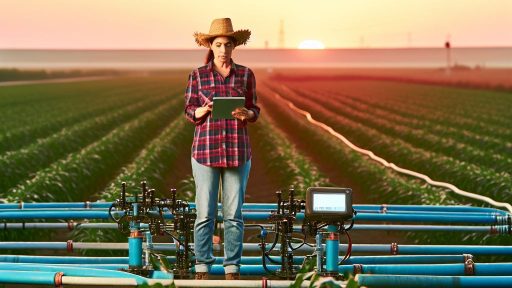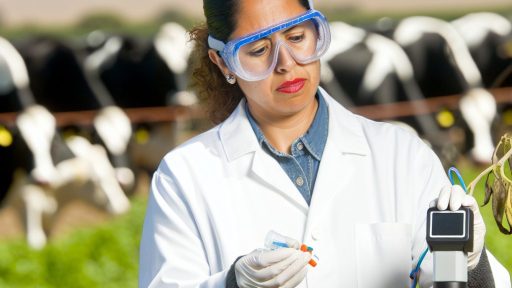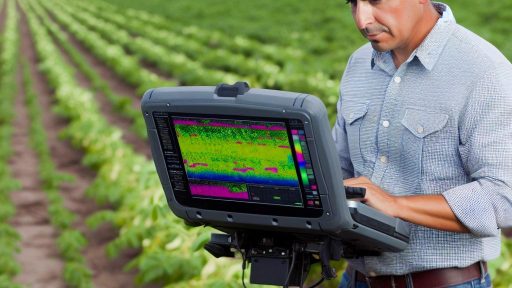Introduction to Energy Efficiency in Agriculture
Energy efficiency plays a crucial role in modern agriculture.
Farmers face increasing energy costs that impact their bottom line.
Moreover, sustainable energy practices contribute to environmental health.
By improving energy efficiency, agricultural businesses can enhance profitability.
In addition, it helps in reducing their carbon footprint.
The Importance of Energy Efficiency
Energy efficiency is vital for economic stability in agriculture.
It enables farmers to allocate resources effectively.
As a result, they can invest in technology and innovation.
Furthermore, efficient energy use leads to lower operational costs.
This savings can be redirected towards improving farm operations.
Challenges in Implementing Energy Efficiency
Despite the benefits, farmers face challenges in energy efficiency.
Initial costs for energy-efficient technologies can be high.
Additionally, there is often a lack of knowledge about available options.
Farmers may also struggle with the integration of new systems.
Lastly, fluctuating energy prices add to the uncertainty.
Transform Your Agribusiness
Unlock your farm's potential with expert advice tailored to your needs. Get actionable steps that drive real results.
Get StartedCurrent Trends in Energy Efficiency
Many agricultural businesses are turning to renewable energy sources.
Solar panels and wind turbines are becoming common on farms.
Additionally, smart technology offers real-time monitoring and control.
This technology optimizes energy use in irrigation and heating systems.
More farmers are considering energy-efficient machinery as well.
Importance of Energy Efficiency for Sustainability
The Role of Energy Efficiency in Agriculture
Energy efficiency plays a vital role in today’s agricultural practices.
It reduces operational costs for farmers and boosts productivity.
By minimizing energy waste, businesses can enhance their sustainability initiatives.
This focus on efficiency leads to more responsible resource use.
Economic Benefits of Energy Efficiency
Implementing energy-efficient practices can significantly cut costs.
For example, using LED lighting in barns lowers electricity bills.
Additionally, energy-efficient machinery reduces fuel expenses.
These savings can be reinvested into improving farm operations.
Overall, lower energy costs create a more profitable agricultural business.
Environmental Impact of Energy Efficiency
Enhancing energy efficiency also positively impacts the environment.
It reduces greenhouse gas emissions associated with farming activities.
Less energy consumption means a smaller carbon footprint for agricultural operations.
By adopting renewable energy sources, farms can further enhance their contributions.
Future Trends in Energy Efficiency
As technology advances, energy efficiency continues to evolve.
New smart farming technologies can optimize energy use effectively.
Precision agriculture tools allow farmers to use resources more wisely.
As a result, the agriculture sector can adapt to changing environmental regulations.
This adaptability is crucial for long-term business sustainability.
Case Studies in Energy Efficiency
Many agricultural businesses have successfully improved their efficiency.
Showcase Your Farming Business
Publish your professional farming services profile on our blog for a one-time fee of $200 and reach a dedicated audience of farmers and agribusiness owners.
Publish Your ProfileFor instance, Green Valley Farms implemented solar panels.
This decision significantly decreased their reliance on traditional energy sources.
Another example is Maple Woods Orchard, which upgraded its irrigation systems.
These upgrades saved water and minimized energy consumption dramatically.
Evaluating Energy Consumption in Agricultural Operations
Understanding Energy Usage Patterns
Assessing energy consumption starts with understanding usage patterns within agricultural operations.
Farm facilities typically use energy for heating, cooling, lighting, and equipment operation.
Tracking energy use helps identify areas for improvement and cost reduction.
Data should be collected from electrical bills, equipment logs, and operational records.
Next, analyze this data to recognize peak usage times and unnecessary waste.
Implementing Energy Audits
Conducting regular energy audits is vital for evaluating energy efficiency.
These audits can reveal inefficiencies in equipment and facilities.
Hire trained professionals to evaluate energy consumption comprehensively.
They can offer recommendations to optimize energy use.
After the audit, implement changes based on the findings.
Identifying Major Energy Consumers
Identify major energy-consuming aspects of your operation.
Heating systems, irrigation pumps, and lighting can contribute significantly to energy costs.
Your goal is to prioritize which systems to address first.
Consider energy-efficient alternatives or upgrades for these systems.
Utilizing Technology for Monitoring and Management
Adopt smart technology for real-time energy monitoring.
Smart meters can provide insights into energy use and peak consumption times.
Dedicated software manages energy consumption effectively across operations.
These technologies help predict energy needs more accurately.
Regularly review data collected to keep your energy management practices effective.
Educating Staff on Energy Efficiency Practices
Provide education and training to employees on energy-saving practices.
Awareness leads to more mindful usage of energy resources.
Incorporate energy efficiency as part of staff training programs.
Encourage staff to propose energy-saving ideas and solutions.
Creating a culture focused on efficiency can lead to substantial savings.
Learn More: Precision Farming Techniques in Controlled Environment Agriculture
Technological Innovations in Energy Efficiency
Introduction to Energy Innovations
Technological advancements significantly enhance energy efficiency in agriculture.
These innovations help businesses reduce costs and minimize environmental impact.
By adopting new technologies, agricultural enterprises can increase productivity.
Precision Agriculture
Precision agriculture uses technology to monitor and manage field variability.
This approach optimizes inputs such as water and fertilizers.
Sensors and drones provide real-time data on crop health and soil conditions.
Farmers can make informed decisions based on accurate information.
As a result, they can achieve higher yields with fewer resources.
Energy-Efficient Machinery
Investing in energy-efficient machinery significantly reduces operational costs.
Modern equipment often uses advanced technology for better fuel economy.
For example, tractors with variable speed and automatic shut-off features minimize energy waste.
Showcase Your Farming Business
Publish your professional farming services profile on our blog for a one-time fee of $200 and reach a dedicated audience of farmers and agribusiness owners.
Publish Your ProfileAdditionally, equipment manufacturers now offer electric and hybrid options.
These machines not only cut fuel costs but also lower carbon footprints.
Renewable Energy Sources
Integrating renewable energy sources can provide significant benefits for agricultural operations.
Solar panels and wind turbines harness natural resources to generate clean energy.
By utilizing these sources, farms can reduce their dependence on fossil fuels.
Moreover, excess energy can often be sold back to the grid.
This revenue stream enhances financial sustainability for farmers.
Smart Irrigation Systems
Smart irrigation systems improve water usage efficiency in agriculture.
Sensors gauge soil moisture levels and adjust watering schedules automatically.
This technology prevents overwatering and conserves water resources.
Consequently, farmers save on water costs and enhance crop health.
Biogas Production
Biogas production harnesses organic waste for renewable energy.
Farmers can convert animal manure into biogas using anaerobic digesters.
This process not only produces energy but also reduces waste disposal issues.
Using biogas enhances energy independence for agricultural operations.
Additionally, leftover digestate can be used as a nutrient-rich fertilizer.
Implications of Technological Innovations
Embracing technological innovations enhances energy efficiency in agriculture.
These strategies contribute to reducing operational costs and environmental impact.
By leveraging advancements, farmers pave the way for sustainable agricultural practices.
Delve into the Subject: How To Choose The Right Agri-Fintech Solution For Your Farm Needs
Renewable Energy Sources for Agricultural Businesses
Benefits of Renewable Energy
Renewable energy offers numerous advantages to agricultural businesses.
First, it reduces dependency on fossil fuels.
This shift results in lower energy costs over time.
Moreover, renewable energy sources are sustainable and abundant.
Using these sources enhances the environmental footprint of farms.
Above all, it contributes to energy independence.
Types of Renewable Energy Sources
Agricultural businesses can utilize various renewable energy sources.
Solar energy is one of the most popular options.
Solar panels can power irrigation systems and other equipment.
Additionally, wind energy is effective in suitable locations.
Wind turbines can generate significant electricity with minimal impact.
Biomass is another viable option for farm energy needs.
This includes using crop residues and animal waste.
Finally, hydropower can provide energy from water resources.
Small-scale hydro systems work well on many farms.
Implementing Renewable Energy Solutions
Transitioning to renewable energy requires careful planning.
First, assess the energy needs of the agricultural operation.
Next, conduct a feasibility study for different energy sources.
This analysis will highlight the most effective solutions.
Furthermore, farms can seek financial incentives or grants.
Showcase Your Farming Business
Publish your professional farming services profile on our blog for a one-time fee of $200 and reach a dedicated audience of farmers and agribusiness owners.
Publish Your ProfileMany governments support renewable energy adoption.
Finally, collaborate with local energy experts for installation.
Case Studies of Successful Implementation
Several farms have successfully integrated renewable energy.
The Green Valley Farm now uses solar panels for its operations.
This shift reduced their energy costs by over 30%.
Similarly, Riverbend Orchards installed a wind turbine.
The turbine provides nearly half of their energy needs.
These case studies highlight the potential for success.
Discover More: Future Trends In Genetically Modified Agricultural Technology
Cost-Benefit Analysis of Energy Efficiency Investments
Energy efficiency investments can significantly boost agricultural productivity.
First, assess the initial costs of implementing energy-efficient technologies.
These costs often include equipment, installation, and training expenses.
Next, evaluate the long-term savings from reduced energy consumption.
Lower energy bills can substantially enhance profit margins over time.
Additionally, consider potential government incentives for energy efficiency upgrades.
Many regions offer tax credits or rebates for such investments.
This financial support can offset initial expenditure costs.
Moreover, analyze the impact on overall operational efficiency.
Energy-efficient practices often lead to streamlined processes and better resource management.
Increased efficiency can also enhance product quality and yield.
For instance, improved heating and cooling systems can maintain ideal growing conditions.
Further, factor in the environmental benefits of energy-efficient practices.
Reducing energy consumption lowers greenhouse gas emissions, benefiting the ecosystem.
These positive environmental impacts can improve a business’s reputation.
Consequently, enhanced public perception can lead to higher sales and customer loyalty.
A thorough cost-benefit analysis is critical.
This analysis empowers agricultural businesses to make informed investment decisions.
Ultimately, energy efficiency investments can yield long-term financial and environmental rewards.
Gain More Insights: Exploring Biotech-Based Fertilizers And Their Benefits

Implementing Energy Management Practices on Farms
Understanding Energy Management
Energy management refers to the strategic approach toward energy use.
Farm managers should prioritize efficient energy consumption.
This practice helps reduce operational costs significantly.
Furthermore, it minimizes the environmental impact of farming activities.
Conducting Energy Audits
Start with a comprehensive energy audit of the farm.
Identify the main consumers of energy in all operations.
Regular audits reveal opportunities for improvement.
Incorporate feedback from staff during audits for greater insights.
Investing in Energy-Efficient Equipment
Replacing outdated equipment can yield significant savings.
Invest in energy-efficient machinery and tools.
Consider solar-powered systems for enhanced sustainability.
Showcase Your Farming Business
Publish your professional farming services profile on our blog for a one-time fee of $200 and reach a dedicated audience of farmers and agribusiness owners.
Publish Your ProfileAdditionally, use LED lighting to reduce electricity usage.
Training Staff on Energy Practices
Educate staff on energy-saving techniques and practices.
Encourage energy-efficient behaviors among all employees.
Workshops can help reinforce the importance of energy efficiency.
Include energy efficiency in regular training sessions.
Utilizing Alternative Energy Sources
Explore renewable energy options for farm operations.
Solar, wind, and geothermal energy provide sustainable alternatives.
These sources can significantly reduce reliance on fossil fuels.
Additionally, they can lower energy costs over time.
Monitoring and Continuous Improvement
Implement monitoring systems to track energy usage regularly.
Data analysis helps identify trends and inefficiencies.
Set benchmarks to measure progress toward energy efficiency goals.
Continually evaluate practices and adjust strategies as needed.
Case Studies of Successful Energy Efficiency Strategies
Innovations at Green Valley Farms
Green Valley Farms implemented solar energy systems successfully.
This innovation reduced their energy costs significantly.
Moreover, the farm produced excess energy, creating additional revenue.
They also installed energy-efficient equipment in processing facilities.
This further minimized electrical consumption and waste.
Adaptive Practices at Oakwood Vineyards
Oakwood Vineyards adopted smart irrigation technology to enhance efficiency.
As a result, water usage decreased without compromising crop yield.
The vineyard utilized sensors to monitor soil moisture levels.
This proactive approach prevented overwatering and conserved resources.
Energy Management at Bright Future Agriculture
Bright Future Agriculture focused on comprehensive energy audits.
The audits identified several areas for efficiency improvements.
By upgrading lighting to LED, they significantly cut energy use.
Furthermore, they optimized their machinery operation schedules.
This strategic change improved energy retention and productivity.
Success Stories from Red Barn Dairy
Red Barn Dairy invested in biogas systems for waste management.
This investment transformed waste into energy for dairy operations.
As a result, they significantly reduced their reliance on external power sources.
Additionally, this strategy enhanced their sustainability profile.
Overall, the dairy experienced lower operational costs and improved efficiency.
Challenges and Barriers to Energy Efficiency Adoption
Financial Constraints
Many agricultural businesses face financial limitations.
The initial investment for energy-efficient technologies can be substantial.
Although savings may occur over time, the upfront costs deter many farmers.
This challenge is especially prevalent for small-scale operations.
Funding opportunities are often limited or difficult to access.
Knowledge and Awareness Gaps
A significant barrier is the lack of awareness about energy efficiency benefits.
Many agricultural businesses are not fully informed about available technologies.
Training programs and workshops are sometimes insufficient or inaccessible.
Showcase Your Farming Business
Publish your professional farming services profile on our blog for a one-time fee of $200 and reach a dedicated audience of farmers and agribusiness owners.
Publish Your ProfileFurthermore, misconceptions about energy-efficient practices persist.
Addressing educational gaps is vital for promoting better practices.
Regulatory and Policy Issues
Regulations can also hinder the adoption of energy-efficient strategies.
Some policies may not adequately support innovative technologies.
State and federal incentives may be complicated or poorly communicated.
Farmers often struggle to navigate the bureaucratic landscape.
Streamlining regulations could encourage more businesses to comply.
Technological Limitations
The availability of appropriate technology can present additional challenges.
Not all agricultural settings can utilize the same energy solutions.
For instance, certain equipment may not be feasible for all crops.
Additionally, some technologies require specialized maintenance skills.
This can lead to increased operational complexity for farmers.
Cultural and Behavioral Resistance
Resistance to change is a common trait in many established businesses.
Farmers often rely on traditional practices that have proven effective.
Adopting new technologies may seem risky without guaranteed results.
Building a culture of innovation is essential for progress.
Peer influence can play a significant role in overcoming resistance.
Future Trends in Energy Efficiency for Agriculture
Integrating Smart Technology
Agricultural businesses are increasingly adopting smart technology for energy efficiency.
These technologies include IoT devices and sensors that monitor energy use.
Farmers can remotely control equipment and optimize energy consumption.
Furthermore, smart agriculture improves resource efficiency and reduces waste.
Sustainable Energy Sources
Future trends show a shift toward sustainable energy sources in agriculture.
Renewable energy such as solar, wind, and bioenergy will play a significant role.
Farmers can not only reduce their energy costs but also lower their carbon footprint.
Additionally, utilizing local energy sources enhances energy security.
Improved Energy Storage Solutions
Advancements in energy storage technology are vital for agricultural efficiency.
Farmers can store excess energy generated from renewable sources.
Battery technology continues to evolve, supporting better energy management.
Consequently, energy storage promotes the continuous operation of farm equipment.
Focus on Energy Audits
Conducting regular energy audits becomes crucial for agricultural businesses.
These audits identify areas of excessive energy consumption and waste.
Businesses can implement targeted strategies to enhance energy efficiency.
Moreover, energy audits support compliance with environmental regulations.
Education and Training Initiatives
Ongoing education and training for farmers promote energy efficiency practices.
Workshops and programs focus on the latest technology and methods available.
As a result, farmers gain the knowledge to implement effective strategies.
Better-educated farmers contribute to a culture of sustainability in agriculture.




